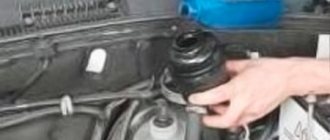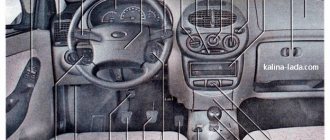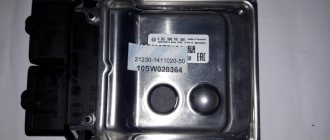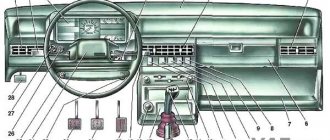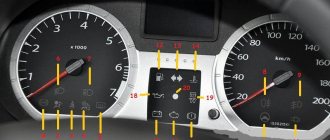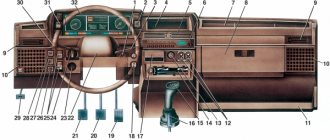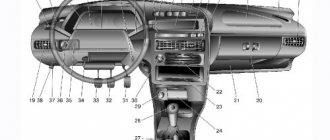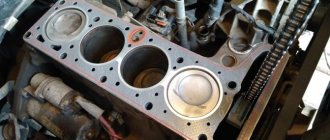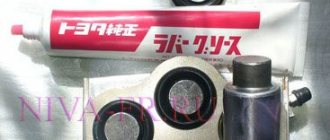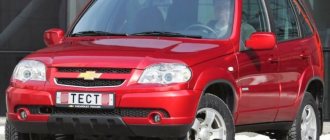The relatively complex scheme for distributing torque from the internal combustion engine to the wheels is explained by the universal purpose of the Niva 2121 - if used correctly, it can be used comfortably in the city and along muddy country roads. Such properties are ensured by the presence of a transfer case with a center differential lock, complementing a 4- or 5-speed manual transmission, depending on the year of manufacture. Lever located closer to the dashboard, is responsible for turning off/on the center differential, the second "small" lever controls the range multiplier and has 3 positions: high and low rows, as well as neutral.
Design and principle of operation of the Niva 2121 transfer case
The transfer case mechanism includes more than 60 independent parts, which is confirmed by the presented drawing. Therefore, it is quite prudent to name the main elements and their purpose.
- Housing Differential housing Shafts Couplings Seals Pinions Gears Flanges Levers
A pair of gears are tightly seated on the drive shaft, one of them (large) is intended for high gear, the second (small) is responsible for low gear. They have serrations with straight and oblique profiles. The first ones are in contact with the coupling, the second ones - with the intermediate shaft. The inclusion of one or another row causes the coupling to move along the hub in the horizontal direction, after which it is connected to the gear on the transfer case drive shaft.
The intermediate position turns off the gearbox ( the gearbox is open ), and the car cannot be moved in this mode. The front helical gear on the intermediate shaft is used to control the differential. The locking is engaged, or the rigid coupling of the drive shafts of both axles, is carried out through a clutch. The design is typical for modifications 21213 and 21214, and the latter is additionally equipped with a speed sensor drive.
In the operating state (with the transfer case reduction gear connected), the gear ratio in the first stage changes from 4.4 to 7.83, the second - from 2.52 to 4.58, the third - from 1.63 to 2.9, in the fourth - from 1.2 to 2.14, fifth - from 0.98 to 1.75, which is expressed in an increase in traction on the wheels.
Vehicle controls
The placement of controls is shown in Fig. 1-4.
- 1 – sound signal switch.
- 2 – device composition panel.
- 3 – control wheel.
On a car with a steering wheel with a built-in safety pad, to turn on the sound signals, press the steering wheel trim in the area marked with the appropriate emblem.
- 4 – shield fastening screw.
- 5 – external lighting switch.
When you press the shoulder button to the first fixed position, the side lights turn on, and to the second fixed position, additional headlights. At the same time, the lamp in the switch illuminates the button.
- 6 – heater electric fan switch.
When you press the shoulder of the key to the first fixed position, the low speed of the electric fan is turned on, and to the second fixed position - the highest speed. When the external lighting is turned on, the key illumination lamp lights up.
- 7 – windshield blower nozzles.
- 8 – central nozzles of the interior ventilation and heating system.
- 9 – control unit for the interior ventilation and heating system.
- 10 – rear window heating switch.
The heated rear window is turned on by pressing the button on the shoulder. When the external lighting is turned on, the key illumination lamp lights up.
- 11 – plug.
- 12 – switch for rear fog lights.
The fog lights turn on when the headlights are on in conditions of limited visibility (fog, snow, rain) by pressing the shoulder button. When the external lighting is turned on, the key illumination lamp lights up.
- 13 – glove box.
- 14 – nozzles for blowing glass of front doors.
- 15 – shelf for a first aid kit, magazines and newspapers.
- 16 – plug.
- 17 – plug.
- 18 – socket for installing radio equipment.
The car is equipped with the installation of radio equipment, corresponding in size to international standards (ISO 7736, DIN 7736), with its positive wire connected to the INT terminal of the ignition switch. With all this, you should keep in mind that the current consumption should not exceed 10 A, and a fuse of the appropriate rating is needed in the power supply circuit of the radio device.
- 19 – gear shift lever.
- 20 – gear shift lever in the transfer case.
- 21 – ashtray.
- 22 – key for fixing the parking brake lever.
- 23 – parking brake lever.
By moving the lever upward, the brake pads of the rear wheels are activated. To return the lever to its initial position, press key 22 and lower the lever.
- 24 – cigarette lighter.
To use, press the chuck key to a fixed position. After approximately 15 seconds, the cartridge will automatically return to its initial position, ready for use. When the device lighting is turned on, the lamp illuminates the cigarette lighter socket.
- 25 – differential lock lever in the transfer case.
- 26 – rear window cleaner and washer switch.
When you press the shoulder of the key to the first fixed position, the windshield wiper is turned on, and to the second non-fixed position, the washer is additionally turned on.
- 27 – switch lever for wipers and washers of the windshield and headlights.
- 28 – gas pedal.
- 29 – control lamp for closing the carburetor air damper.
Lights up orange when the ignition is turned on and handle 30 is pulled out.
- 30 – handle for closing the carburetor air damper.
Serves to start a cool engine. When the handle is pulled out one hundred percent, the carburetor air damper is closed; when it is recessed, it is open.
- 31 – alarm switch.
When you press the button, the blinking light of the direction indicators and the warning lamp in the button itself turns on. The alarm goes off when the key is pressed again.
- 32 – brake pedal.
- 33 – ignition switch.
- 34 – clutch pedal.
- 35 – direction indicator switch lever.
- 36 – fuse blocks.
- 37 – hood lock drive lever.
- 38 – device lighting regulator.
Rotating the knob adjusts the brightness of the device lighting and the illumination of signs if the external lighting is turned on.
- 39 – headlight hydraulic corrector.
By rotating the knob, depending on the load of the vehicle, the angle of the headlight beam is adjusted so that oncoming drivers are not dazzled.
The position of the handle in the order of increasing diameters of the circles on the hydraulic corrector scale means:
- one driver;
- all seats are occupied or all seats are occupied plus cargo in the luggage compartment up to the permissible overload on the rear axle;
- one driver plus cargo in the luggage compartment up to the permissible overload on the rear axle.
For other loading options, without exceeding the useful weight, the middle position of the handle is selected.
- 40 – headlight switch lever.
- 41 – composition of devices.
Source: www.vazbook.ru
How to use a transfer case with a range multiplier on a Niva 2121
The normal position for the RK handles, ensuring adequate behavior on the road of good quality:
- Front - away from you Back - towards you
The special operating mode of the transmission is switched on not long before the car begins to overcome an obstacle (rut, mud, ford or rise). The transition to the lowest row must be done while stopping. Returning to top gear is allowed on the go, although it causes problems for beginners due to the lack of the usual synchronizer. It is somewhat more difficult to properly handle the forced manual locking of the center differential. On the contrary, it turns on when the car moves slightly (up to 20 km/h) due to misalignment of the grooves on the locking clutch, satellites and ring gear. To simplify turning the lever into the desired position, taking into account the Niva 2121 transfer case, pick up a small speed, then, shaking the steering wheel, pull the handle towards you.
Problems can also arise when disengaging the lockout, as the clutch teeth literally catch on the ring gear. Engage reverse and, rocking the steering wheel, push the lever away from you. This action is performed immediately after overcoming a difficult section in order to avoid overloading the gearbox. It is most effective to disable the differential together with the transition to lower stages. In this case, only diagonal suspension of the wheels can stop a Niva 4x4, since standard inter-wheel locking is not provided. When performing the above operations, you must not give free rein to physical strength. An attempt to “push” the transmission will most likely result in expensive repairs.
Controls of VAZ 21214
External lighting switch When you press the lower arm of the key, the side lights are turned on before the first fixed position, and the headlight circuits are additionally energized before the second fixed position. At the same time, a special lamp in the switch illuminates the button.
Heater fan switch Is energized when the ignition is on. When you press the lower arm of the key, the low speed of the electric fan is turned on to the first fixed position, and the highest speed is turned on to the second fixed position. At the same time, a special lamp in the switch illuminates the button.
Rear window heating switch Is energized when the ignition is on. The heated rear window is turned on by pressing the lower arm of the button. If the device lighting is turned on, an orange lamp illuminates the switch button.
Rear fog light switch Is energized when the headlights are on. The fog lights are turned on in conditions of limited visibility (fog, snow, rain) by pressing the lower arm of the key.
Parking brake lever Moving the lever upward activates the brake pads on the rear wheels. To return the lever to its initial position, press key 22 and lower the lever.
Cigarette lighter To use, press the key to the fixed position. After approximately 15 seconds, the cartridge will automatically return to its initial position, ready for use. When the device lighting is turned on, a special lamp illuminates the cigarette lighter socket.
Rear window wiper and washer switch Is energized when the ignition is on. When you press the lower arm of the key to the first fixed position, the windshield wiper is turned on, and to the second non-fixed position, the washer is additionally turned on.
The indicator lamp for closing the carburetor air damper lights up in orange when the ignition is turned on when handle 30 is pulled out.
Hazard warning switch When you press the button, the blinking light of the direction indicators and the warning lamp in the button itself turns on. The alarm goes off when the key is pressed again.
Device lighting control Rotate the knob to adjust the brightness of device lighting if the external lighting is turned on.
Hydrocorrector of headlights Rotating the knob, depending on the load of the vehicle, adjusts the angle of the light beam so that drivers of oncoming traffic are not dazzled by low-beam headlights. The position of the handle in the order of increasing diameters of the circles on the hydraulic corrector scale means: – one driver; – all seats are occupied; – all seats are occupied plus cargo in the luggage compartment up to the permissible overload on the rear axle; – one driver plus cargo up to the permissible overload on the rear axle.
For other loading options, without exceeding the useful weight, the middle position of the handle is selected.
Source: zinref.ru
Possible problems
Harsh operation and insufficient attention to how to use the transfer case on the Niva 2121 lead to the appearance of:
- Vibrations in the body while moving Vibrations when starting Hum Noise when maneuvering Tight switching on modes
Experience shows that the culprits are: insufficient oil level, incorrect centering of the steering wheel, loosening of the support fastenings and damage to the rubber bands. An additional influence is exerted by the condition of the cardan and the engine itself.
All-wheel drive jeep VAZ-2121 "Niva". This car became a real sensation in the domestic automobile industry. Her appearance was preceded by numerous rumors, conjectures and gossip. The Soviet car enthusiast, not spoiled by the quality of roads, has long needed a comfortable passenger all-wheel drive SUV, which could be used with equal success both on asphalt and off-road. And in 1977, it rolled off the assembly line of the Volzhsky Automobile Plant - the first mass-produced all-wheel drive Niva.
It cannot be said that before the release of the Niva there were no off-road vehicles in the country. Were. True, mostly not civilian jeeps, but military cargo-passenger all-terrain vehicles, intended primarily for use in the armed forces. Of course, a certain number of these vehicles ended up in the national economy, but there were practically no all-terrain vehicles in personal ownership.
Nevertheless, the Soviet automobile industry has repeatedly made attempts to create comfortable passenger SUVs. Thus, back in pre-war 1938, a prototype of the first Soviet passenger all-terrain vehicle, intended for the senior command staff of the Red Army, was created at the Gorky Automobile Plant.
The car, named GAZ-61, was created on the basis of the GAZ-11-73 emka with a six-cylinder engine producing 85 hp. The car turned out to be extremely successful - on the highway with a full load, the all-wheel drive Emka reached speeds of up to 107.5 km/h, and its cross-country ability was such that even today it could easily compete off-road with the coolest modern jeeps. SUVs. Serial production of the GAZ-61 began at the beginning of 1941; it continued until August of the same year. Many of these vehicles survived the entire war; Such prominent Soviet commanders as G. Zhukov, I. Konev and K. Rokossovsky drove the GAZ-61.
In the post-war years, with the launch of the GAZ-M20 Pobeda car into production, the question of creating a domestic comfortable all-terrain vehicle was again raised - mainly for the party and economic leadership of rural areas. This SUV, called the GAZ-M72, was created on the basis of the Pobeda body and units of the GAZ-69 army all-terrain vehicle. This car became the embodiment of the concept of comfortable jeeps - foreign automobile companies did not even think about such cars at that time.
The first domestic passenger SUV GAZ-61 (1941)
All-wheel drive GAZ-M72 is a hybrid of the GAZ-69 army jeep and the Pobeda M-20 passenger car (1955)
Comfortable subcompact jeep "Moskvich-410" produced by MZMA (1957)
Rural SUV LyA3-969M based on the units of the Zaporozhets car (1979)
Experimental "Moskvich-416" based on the all-wheel drive vehicle "Moskvich-410N" (youth of the 1950s)
The domestic comfortable jeep VAZ-2121 is the first original development of the Volga Automobile Plant (1977)
The car was equipped with a transfer case with a range and a switchable drive front axle. With 16-inch wheels with increased lugs (such as the all-wheel drive Niva is now equipped with), the car had significant ground clearance, which provided it with good cross-country ability in mud, sand, snow, arable land and broken roads. The car was produced in a small series from 1955 to 1958. It’s a pity that the production of this kind of car was not properly continued - for our country, with its off-road conditions, such a car would be priceless. With the completion of the Pobeda production, the production of the GAZ-M72 also ceased.
The need for a similar all-terrain vehicle, however, not only remained, but even increased. In the 1950s, ordinary passenger cars “Muscovites” and “Pobeda”, which did not have all-terrain qualities, increasingly began to become the personal property of citizens. During these same years, the mass allocation of gardening and dacha plots to city residents began, which, as a rule, were cut off by off-road conditions from the few paved roads.
VAZ-2131. Controls
Rice. 13. Controls
The placement of controls is shown in Fig. 13.
1 – sound signal switch. 2 – device composition panel. 3 – control wheel. 4 – shield fastening screw. 5 – external lighting switch. When you press the shoulder button to the first fixed position, the side lights turn on, and to the second fixed position, additional headlights. At the same time, the lamp in the switch illuminates the button. 6 – heater electric fan switch. When you press the shoulder of the key to the first fixed position, the low speed of the electric fan is turned on, and to the second fixed position - the highest speed. When the external lighting is turned on, the key illumination lamp lights up. 7 – windshield blower nozzles. 8 – central nozzles of the interior ventilation and heating system. 9 – control unit for the interior ventilation and heating system. 10 – rear window heating switch. The heated rear window is turned on by pressing the button on the shoulder. When the external lighting is turned on, the key illumination lamp lights up. 11 – block of indicator lamps for turning on the heated rear window Ш] and turning on the differential lock 1-Ф1. 12 – plug. 13 – glove box. 14 – nozzles for blowing glass of front doors. 15 – shelf for a first aid kit, magazines and newspapers. 16 – plug. 17 – switch for rear fog lights. The fog lights turn on when the headlights are on in conditions of limited visibility (fog, snow, rain) by pressing the shoulder button. When the external lighting is turned on, the key illumination lamp lights up. 18 – socket for installing radio equipment. The installation of radio equipment must be carried out only on a certified PSSS with an indispensable mark in the service book.
Price
And the most important thing is the price. Those who still decide to dent the stock panel for “comfort” will have to pay a little more than 7 thousand rubles
Didn't find the information you are looking for? on our forum.
We recommend reading:
How to increase the charging of a VAZ 2110 generator, increase the voltage by soldering a diode
How to fix VAZ 2107 bridge humming
VAZ 2112 16 valves operating temperature
The order of armored wires on the VAZ 2109
How to remove a spring on a VAZ 2107
Wiring diagram of VAZ 11113 Oka with description
Gasoline consumption VAZ 2115 injector, city, highway, combined cycle
How to install a pump on a VAZ 2114. Do-it-yourself replacement
Off-road driving
Many praise this model for its diligent behavior in off-road conditions, but we are only talking about the 4x4 version, since a single-wheel drive crossover is too tough for real off-road driving. So, off-road tuning of a Chevrolet Niva is not as complicated as it might seem and is limited to installing the following elements:
- Tires and wheels will improve the position of the car relative to the road and improve the ability to rake. A more radical alternative is represented by a lift kit.
- The body kit must be made of steel pipes; make sure there is a platform for the winch. The plastic Chinese version will not withstand real load.
- Installing a winch is necessary not only when participating in competitions; this accessory will also help pull a car (not just your own) out of a ditch or hole.
- Also, off-road tuning requires the presence of a snorkel. We are talking about a special pipe for taking in air and protecting the car engine from water getting into it. The output of such a pipe is carried out on the roof.
Instrument cluster
The figure below shows an instrument cluster that contains the following indicators:
1 – coolant temperature. If the arrow moves into the red zone, you should stop immediately, because The engine gets very hot;
Something to remember! It is prohibited to operate a vehicle with an overheated engine. It is necessary to take the car to a service station to determine and eliminate the cause of engine overheating;
2 – tachometer. Designed to inform the driver about the crankshaft rotation speed. The red zone of the indicator indicates that the engine is running at high frequency, which can be detrimental to the engine;
3, 4 – indicator lamps for turning on left and right turns, respectively. Lights up with green flashing light;
5 – speedometer;
6 – fuel level;
7 – fuel reserve. Orange color. Lights up if the amount of fuel remaining is less than 6 liters;
8 – side light indicator;
9 – brake emergency indicator. Red color. Lights up if the fluid level in the brake hydraulic reservoir is below the min mark;
Something to remember! It is prohibited to drive a vehicle with the emergency brake indicator on.
10 – high beam. Blue color;
11 – “Reset readings” button;
12 – vehicle mileage. The top line shows the total mileage, and the bottom line shows the daily mileage. To reset the daily odometer readings, you need to hold down button 11 for 5 seconds. The car must not move;
13 – “Check engine” lamp. When the ignition is turned on, the indicator lights up; if there are no faults, the lamp goes out. If any problems are detected, the light is constantly on;
14 – indicator of the included alarm system. Red flashing color;
15 – indicator of on-board network, clock, temperature;
16 – battery charge indicator;
17 – parking brake activation indicator. Red color;
18 – indicator “Not enough engine oil”. Red color. Lights up when the engine starts; if the indicator does not go out after starting, then it is necessary to add oil;
19 – reserve.
Possible faults
What malfunctions are typical for the device:
- Light bulbs don't work. If all the backlight fails at once, most likely the problem lies in poor power supply. If only a few or one lamp does not work, then the indicator should be replaced with a new one.
- The speedometer does not work. An electronic problem can be solved by dismantling the device and looking for a bad contact or a failed board element. The problem of tachometer breakdown is solved in the same way.
- Mechanical damage to the device due to impacts and other impacts on it. If the device stops working because of this, it must be removed and tested to determine the failed element.
- Broken wires, this malfunction can also be attributed to mechanical failures.
- Once connected, the new device may not work due to incorrect connection.
- Oxidation of the contacts on the plugs, which may cause sensors and controllers to not work. The problem is solved by cleaning the contacts.
Also interesting: Replacing a Chevrolet Niva pump, step-by-step instructions (photos and videos).

